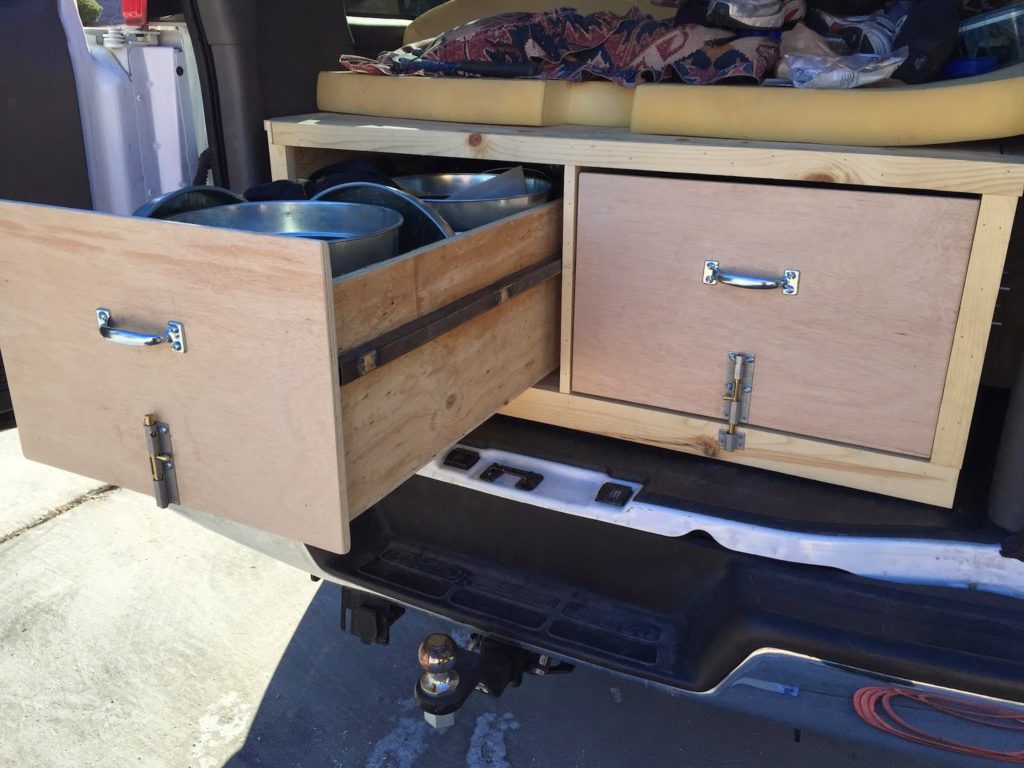
The objectives of this project were the following.
First create Sliding Drawer storage in the rear of a Chevy Express van. The drawers are to ride on roller bearings to support lots of weight and for ease of use.
Additionally there will be a 30 gallon fresh water storage tank. This will be wired and plumbed to a 12 volt RV water pump to provide pressurized water.
Lastly the deck over the drawer space will be fitted with foam cushions and provide a comfortable sleeping area over 6 feet long and about 5 feet wide.
With some minor modifications this drawer system could be adapted for a pick up truck with a camper shell covering the truck bed, or various other SUV’s.
The project was started by creating some anchors for the wood deck. Electrical strut was attached to the van floor using eye bolts and the original seat latching pins that are recessed into the floor, of a Chevy Passenger van. This provided a means to secure the wood to the van floor, and allows leveling with carpet shims out at the ends of the strut.
Two floating pieces of strut were attached to the underside of the far ends of the bottom plywood, at areas that have no seat floor connectors. These floating pieces of strut were shimmed to level using nuts and washers underneath. This installation allows the drawer box to be removed and the van returned to original, without drilling any holes in the floor of the van.
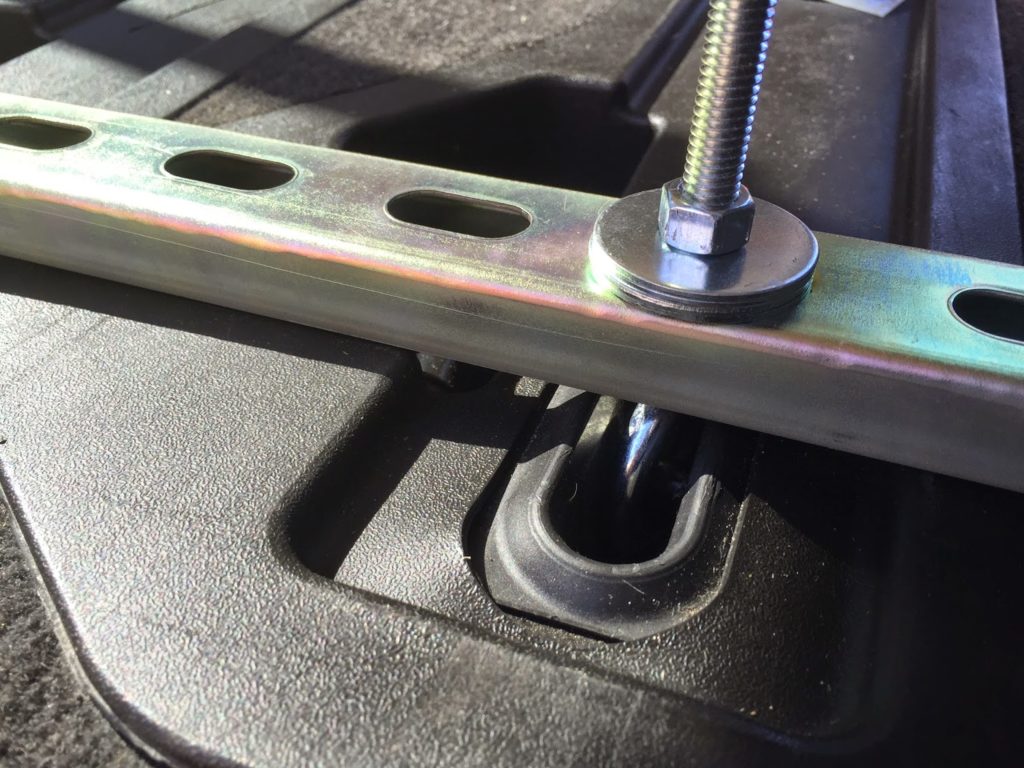
Right off the bat problems started. The threads of the eye bolts did not go far enough on the bolt shaft.
It took 3 fender washers to make up the difference. I ended up pulling all the eye bolts out and used a thread cutting die to cut threads further down the shaft. After that these worked out with one washer as originally planned.
This washer and nut will be recessed in the ¾ inch drawer box bottom panel. I did not want them sticking up any higher than necessary. I could have left the eye bolts floating, and eliminated that set of washer and nut.
With the bolts secured and rigid in place, it made dragging the drawer box assembly a lot easier…. to do the lining up, and dropping over the vertical bolts. A second fender washer and nut gets spun down on top of the drawer box bottom panel. This secures the box to the floor quite well.
Easy means of removal later, if ever that is needed.
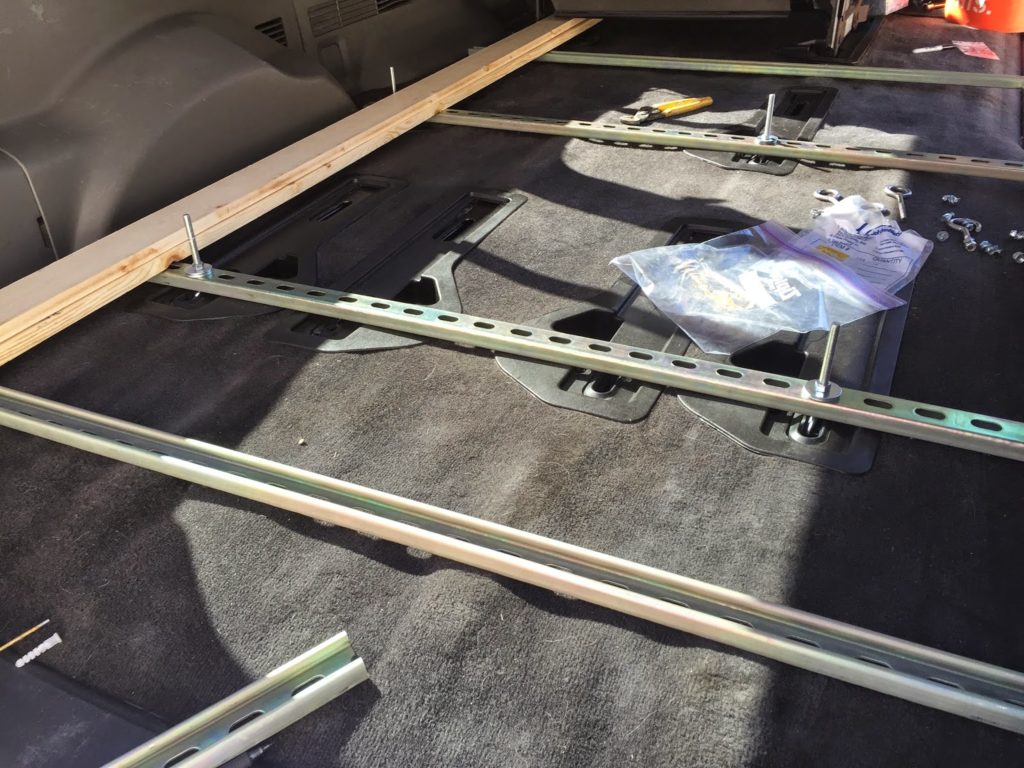
Next came positioning layout of water storage tank and RV On demand water pump. The tank and pump were already mounted in the van previously. It was originally mounted vertical, the long way, behind the 3rd row seat. (2nd & 3rd row rear seat have now been removed).
Though the tank show here is flat on the wide side, it actually was installed with one of the narrow sides face down on the plywood. That way it took up less space I wanted for drawers.
I did leave enough room to install the 12V RV water pump, and a full size AGM Battery. I also figured in a bulkhead and bottom stringer for that, using space in the water tank compartment.
Be sure to figure the passenger side clearance so that the vehicle jack compartment can be accessed, opened, and you can get the jack out.

At this point the assembly is about too bulky and heavy to handle by one person. Once I have the water tank positioned, the cross bulkhead panel, and attaching stringer locations were marked. This would eventually sectioned off the water tank area.
The shown assembly was then marked to saw cut out some sections of the bottom deck to lighten the load too. 4 dead areas of the wood plywood decking were cut out to reduce weight, but retain strength and leave material to attach all vertical partitions.
The assembly was pulled back out of the van. (Notice the protruding anchor bolts with no washers or nuts yet)
The cross bulkhead panel was installed to create the water tank chamber. A vertical center divider was run perpendicular to the bulkhead panel and attached to the bulkhead and the floor to create (2) drawer chambers about 22-23 inches wide. The end cap with drawer openings was then built and attached.
All panels are being screwed together in case this ever needs to be removed from the vehicle. Once the bottom panel was cut to lighten the load, the bulkhead panel attached, and the vertical divider screwed into place, this assembly was re-inserted in the van.
The anchor bolts then have fender washers and nylon lock nuts spun down against the plywood deck. The excess threaded bolt lengths were ground flush with the top of the nuts.
The remainder of the wood construction will be complete inside the
vehicle.
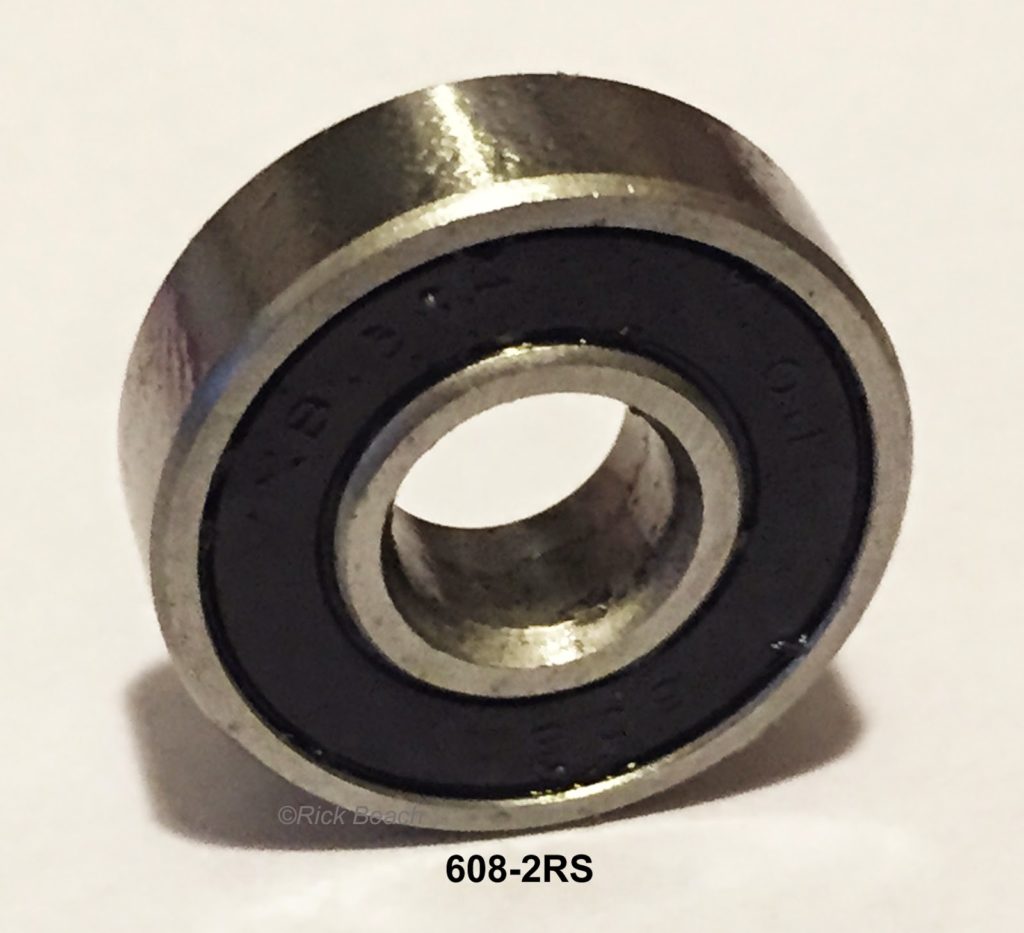
Roller bearing drawer guides were then installed on the inside of both sides of the box, as well as both sides of the vertical center divider.
These will be skate board bearings part number 608-2RS. These are 8mmX 22mmX 7mm. Or about 7/8 inch OD X 5/16 ID hole X 5/16 wide. Some places want $4 to $6 each for these. I found them on eBay for about 40 cents each with free shipping, if ordered in lots of 100. I thought I might need 150 of them. So three days later my package of 200 arrived at my door step.
The drawer sides each have a 1×1 square steel tubing attached to both sides. This side tubing became the drawer rails. This tubing rail will ride on a long row of roller bearings, as well as a row of 4 on top (4 toward the drawer openings) above the tubing to support the extended drawer weight.
A removable “End Stop” needs installed through the very end of each rail after installing the completed drawers. (Drill a hole through the top end of the rail toward the very end of the rail toward the front of the vehicle. Weld this nut on the inside of the tubing end lining up the nut threads with the hole you drilled. After installing the completed drawers, screw a short bolt down into the threads of the nut. This will catch one the first of the top roller bearings and prevent the draw from pulling all the way out.
Next I needed to fabricate (4) 1X1 steel drawer rails. These would be mounted on the sides of the drawers, and ride on the roller bearings. I preferred to side mount mine. The steel tubing would true up the sides of the long drawers. Sigh….it is so hard to find straight lumber any more….even plywood.
I cut my steel tubing to length and marked off bolt placement. My design would require drilling thought the tubing with a 5/16 inch bit. Once all holes were drilled in the tubing I laid these out on my drawer sides. They were clamped into place, marked with bolt direction, marked top, and which side of which drawer these mated up with.
Then I drilled through the holes in the tubing, and on through the side of the drawer. This was done because no matter how well you mark and drill the tubing, none of the holes would be consistent. The clamps were removed and brazing of the bolts was next on the agenda.
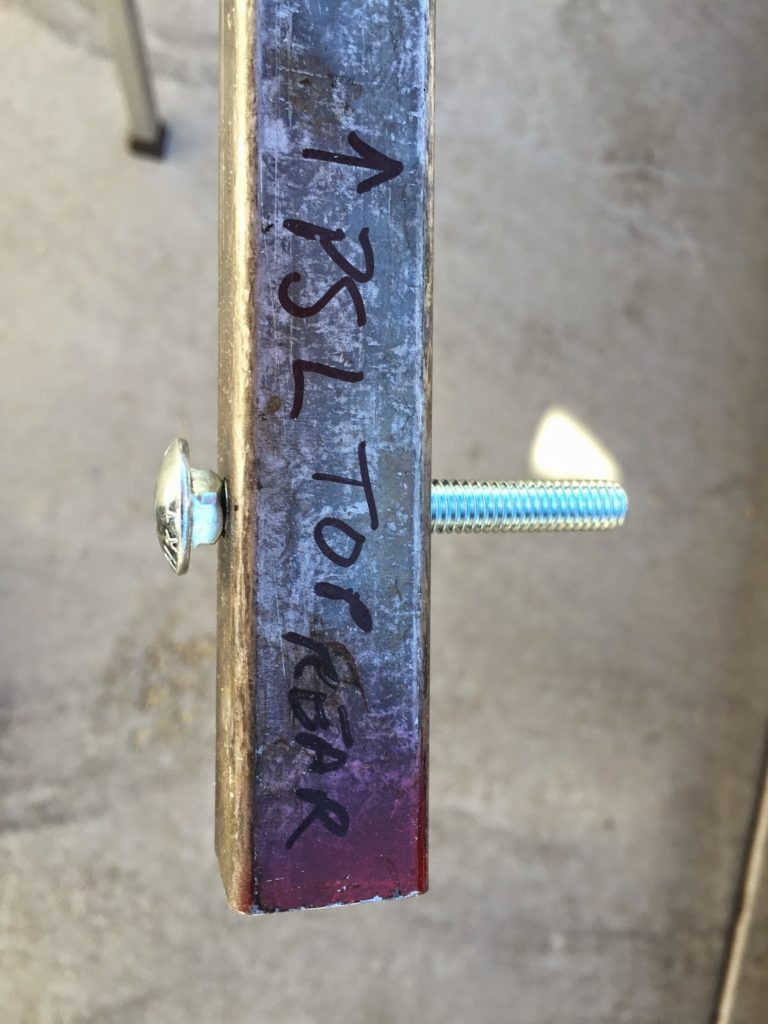
Carriage bolts were used to make sawing the heads off easier than using a
standard hex head bolt. I insert the carriage bolts through the hole, brazed the
bolt on the thread side. Then power hack sawed off the bolt head. Once the
bolt head was removed I brazed this flush cut end to the tubing…finishing off
that side by hitting it with grinder to make it flush and smooth.

Here I have 4 complete rails. They were matched up with the corresponding drawer side. Using a rubber mallet the bolt ends were pounded into the pre-drilled holes in the drawer sides. A flat washer and a nylon locking nut secured all bolts. The excess threads were sawed off and ground smooth with a grinder.
Not shown are the welded nuts inside the end of the tubing to act as drawer stop mounts.
Roller bearing placement was marked.
(4) on top starting 2 inches in from
the drawer face opening, then every 5 inches on center.
(4) on the bottom
exactly lined up with the four on top. Then bottom bearings every 12 inches.
Toward the back add a couple that are spaced every 5 inches to carry the load
when drawers are closed and you are traveling.
You want these two rows to be precise. Almost creating a clamping action between the top and bottom row, to secure the metal rail in between. You want no slop. Ideally when traveling down the road, the rail will have no room to bounce up and down. You do not want it to rattle or squeak.
The roller bearings are mounted using 5/15 inch bolts, nuts, flat washers, and nylon lock nuts. Those in the center are mounted on a common threaded 5/16 rod using lock nuts, flat washers, and nylon locking nuts. Excess threaded ends are cut off and ground smooth.
You may want to install more bearings on the bottom row depending on your
intended load. The top row you want just the 4 shown, or your “stop” bolt will
not allow the draw to come out far enough.

Shown above the drawers were rough fitted and work great. The drawers inside measurements are about 56 inches long, 20 inches wide and about 15 inches deep. ¾ inch sides and ½ inch bottoms. These are heavy duty. Made with 3/4 plywood.
At this stage, the drawers are roughed in and actually functional. I was able to test them out over a 3 day camping weekend. I loaded them full. There were Cast Iron cooking skillets, pots, tools, camp stove, etc. All this gear was heavy stuff. The intent was to really test out the drawers. The drawers worked great, even minus the drawer fronts, handles and trim.

I spend most of a day wiring and rough plumbing the fresh water storage tank. The fill tube and faucet are plumbed to the side door for easy access.
Shown here you see a fill tube, pressurized faucet, vent, and a tank drain faucet. All the lines are run including the pump and connection to the 12V RV pump.
,As I indicated earlier, these are at the side door and overhang the step which has a plastic step liner. The backboard where the faucets protrude will be covered in tile, stainless, or aluminum. That way any drips or spray will end up on the step, and not on the carpeting.
Plumbing and wiring all hooked up. Tank partially filled. Pressure tested to make sure there are no leaks.
Plumbing and wiring all hooked up. Tank partially filled. Pressure tested to make sure there are no leaks.
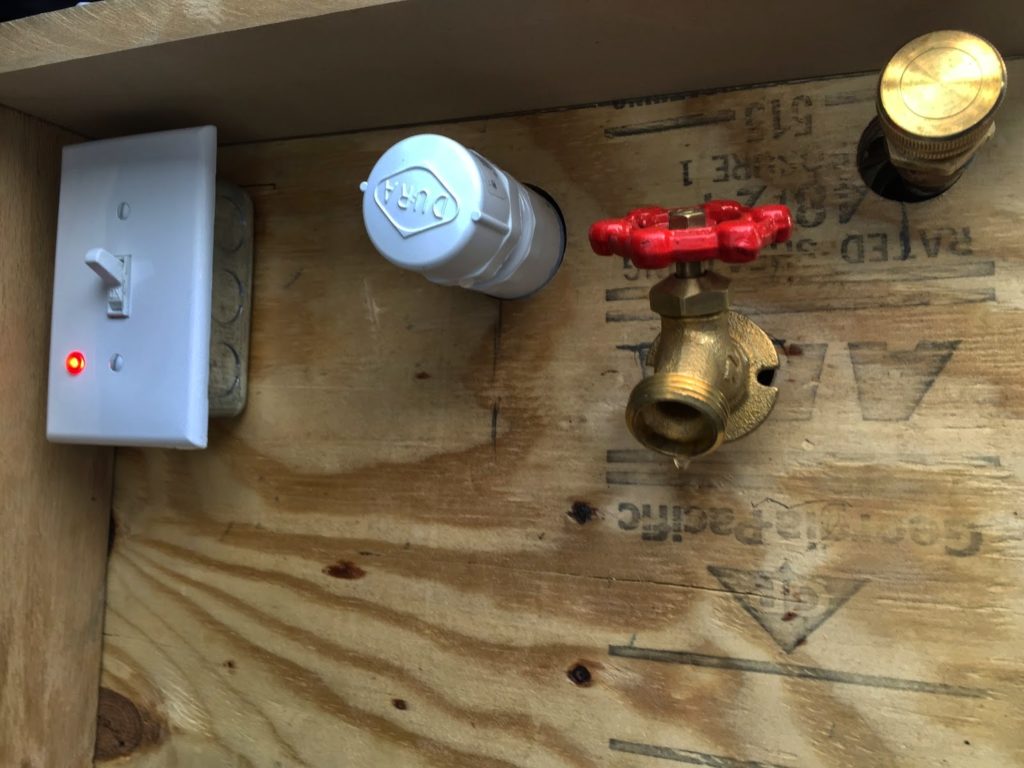
Installed off/on switch for the pump. I included a LED reminder indicator for when that the power is on.
Shown below is the same area covered with white cracked ice finish FRP Wallboard. This is a non porous polyester resin material available from Home Depot. This was scrap left over from another project. It was applied with contact cement.

The images below show the completed drawer fronts. With pull handles installed. Also each drawer has a locking deadbolt latch to prevent the drawer from rolling back and forth during vehicle stopping or accelerating.
I use a rubber “Door Handle Stop” on the front end of the drawer where it nearly touches the bulkhead. The Door Handle Stop acts as a rubber cushion or shock absorber. I have to apply slight inward pressure on the drawer handle to enable me to drop the deadbolt in place. This keeps the drawer from making back and forth noise, or deadbolt rattle, while driving.
The deck was fitted with individual drop-in access panels over each drawer and the water tank/battery compartment. Two dead spots along the sides that provide further storage, also have drop in deck lids. Finger holes were drilled in the drop-in panels to allow easy access from the top too.
A 3 inch foam mattress on top of the deck was made in 3 sections. It provides an oversized bed. Configured to allow top opening access to one drawer at a time. Or top access to the water tank/pump/battery compartment.
The vertical panel facing front was covered with gray carpeting. Corners trimmed with ¾ inch aluminum angle. Exposed drawer fronts are to be painted charcoal gray to match the vehicle interior.
A 3 inch foam mattress on top of the deck was made in 3 sections. It provides an oversized bed. Configured to allow top opening access to one drawer at a time. Or top access to the water tank/pump/battery compartment.
The vertical panel facing front was covered with gray carpeting. Corners trimmed with ¾ inch aluminum angle. Exposed drawer fronts are to be painted charcoal gray to match the vehicle interior.

![]()

